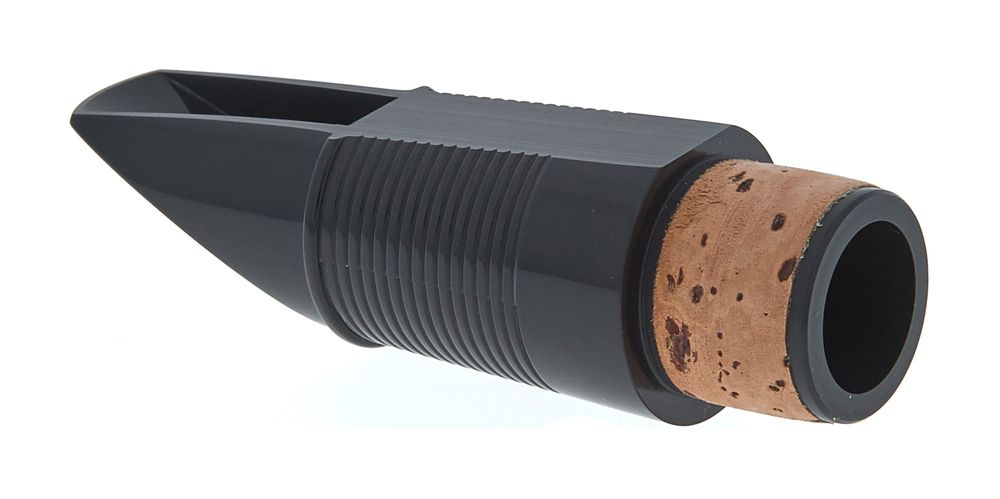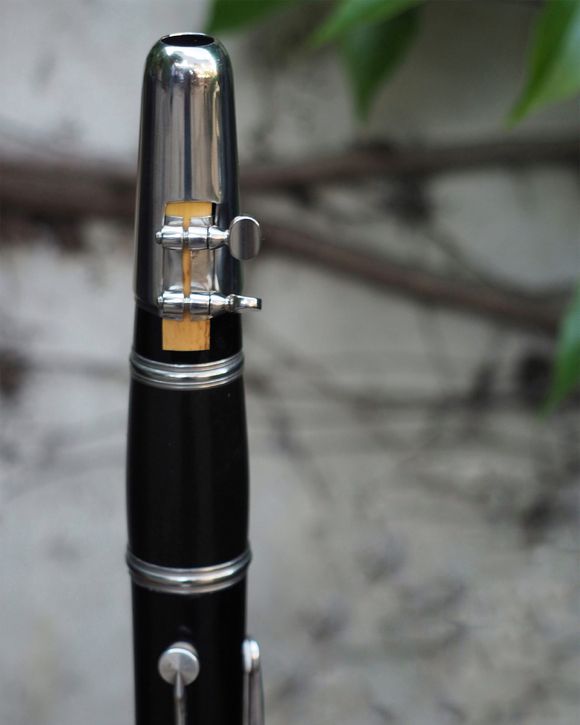9. The Mouthpiece and The Reed
The mouthpiece has the most significant influence on the sound of a clarinet compared to all other components. Advanced players often use two different mouthpieces. The best way to find a suitable mouthpiece is to try out various models.
There are differences in the design and size of the tip opening.
Tip Opening
The tip, especially the opening, is crucial, so let's take a closer look: What exactly is the tip? The sloping facing towards the mouthpiece tip ensures that the reed, even during the loudest fortissimo, never completely closes the mouthpiece and does not flatly hit the edge of the facing, creating a buzzing noise. To characterize the facing, the values of length and opening are combined. It is possible to have a specific length with different openings. Both values are determined when the model is named.
Each player has a different blowing technique, influenced by factors like individual jaw position. The sound outcome with the same reed and mouthpiece can vary greatly. Nevertheless, a few general statements can be made. Short facings, compared to long facings, don't allow for pronounced vibrato. However, the upper registers are easier to play with short facings. A narrower facing limits the dynamic range because the reed's vibration movements are smaller.
Narrow and medium facing openings with a long facing and harder reeds produce a focused tone that convinces with clear intonation and response even in large interval leaps. This is crucial for musicians playing in the symphonic domain. The more open the facing, the more voluminous the tone, but the breathy sound component also increases. This smoky sound is desired, especially by saxophonists and in jazz. However, it shouldn't be too open, as a longer and more open facing also makes intonation more challenging. The blowing resistance increases, and players often use lighter reeds.
Mouthpiece Material
Clarinet mouthpieces come in various material variants. The most well-known material is rubber. However, experts often refer to it as ebonite. In terms of sound, this material spans the entire range of possibilities, with a preference for the soft, slightly "woody" sound in clarinet playing.
Some companies also offer eye-catching mouthpieces made of crystal glass. If you're thinking these mouthpieces might break easily upon impact, rest assured no mouthpiece, regardless of the material, benefits from falling. Unfortunate falls can quickly result in a chipped mouthpiece. In terms of sound, crystal mouthpieces are characterized by a radiant tone, which sounds louder and more penetrating compared to rubber mouthpieces.
Less common but well-known for the warm clarinet sound are wooden mouthpieces. Preferred wood types include grenadilla and ebony.
The most affordable mouthpieces are made of plastic. Unfortunately, their tone quality is not what most clarinetists wish for. The sound, especially in the upper registers, is very sharp, slightly "plasticky" However, they are easy to maintain, and it always comes down to the purpose the mouthpiece serves.
It's important to note that many factors play a role in answering the question of how the material affects the clarinet's sound. The same mouthpiece can produce a new sound when used with a harder or softer reed. But more on that in the section on reeds.
Reeds
The actual sound production occurs on the reed, often referred to as the "soul" of the clarinet. A bad or wrong reed can dampen the joy of playing. Reeds are made from cane, usually in reed-growing regions in southern France and Spain. Reeds are offered in different strengths, on a scale from 1 to 5, with up to three intermediate sizes, depending on the manufacturer.
Thinner reeds, sometimes referred to by musicians as "soft" or "light," are more comfortable to play and can produce quieter tones more easily. However, they may have poorer sound quality and are more prone to overblowing. Thicker reeds, sometimes referred to as "hard" by musicians, can be challenging to intonate but allow for greater volume and, especially in solo playing, more expressive play. Thicker reeds in ensemble play require individual musicians to exercise more tonal control.
The choice of reeds depends not only on playing abilities but also on the mouthpiece. As a basic rule, the larger the opening, the lighter the reeds should be. Conversely, the smaller the opening, the harder the reed should be.
Ligature or Cord
Another element that completes the triad is the ligature. When attaching the reed to the mouthpiece, clarinetists have two options. Either the commonly-used ligature or a cord.
The cord is the traditional way to attach the reed to the mouthpiece. The mouthpiece and reed are wrapped with a cord, allowing the reed to swing optimally. However, this type of reed attachment requires some practice. Those working with a cord must make a decision if they want to continue using it, before buying a new mouthpiece. Many mouthpieces are available in two versions, one for ligature and one for cord.
The simpler and faster method is attaching the reed with a ligature. Here, the selection is almost as extensive as with mouthpieces. Ligatures come in leather, plastic, or metal. The simplest variation looks like a basic clip that is tightened with two screws. However, one-handed reed and mouthpiece fixation is now more prevalent with ligatures using a single screw. More elaborate models have a special contact surface for the reed. Sometimes made of rubber, sometimes made of metal in various shapes. According to the manufacturer's information, certain contact pads are particularly suitable for short tones or fast runs. However, several factors play a role here too: so try as many combinations as possible out, before buying!









